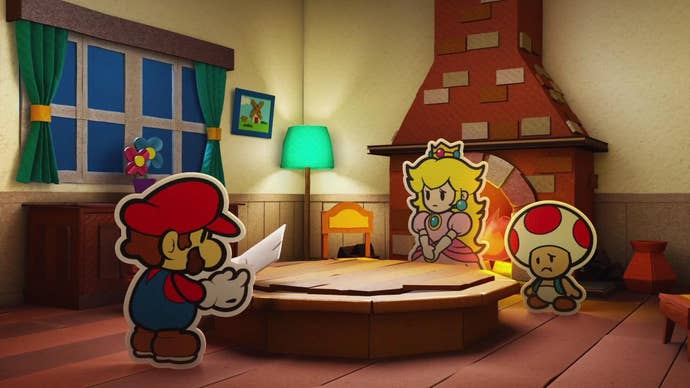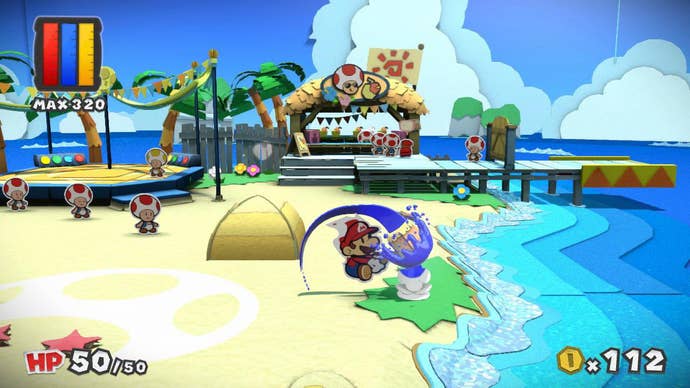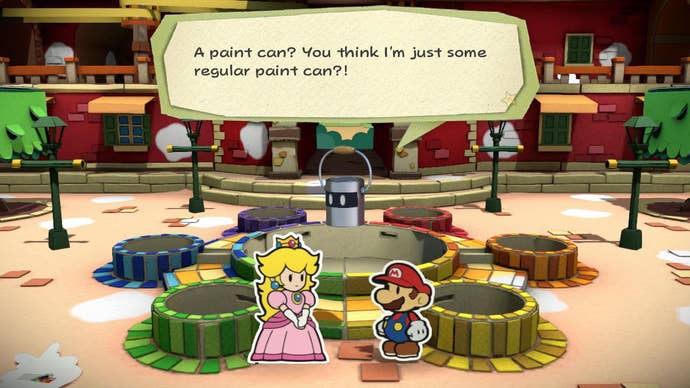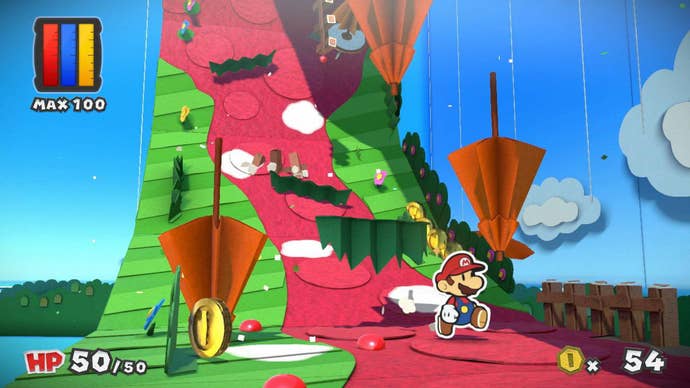Paper Mario: Color Splash Wii U Review: Flinging Hue, Throwing Shade
Mario's latest is a beautiful, rollicking adventure that's been folded, spindled, and mutilated by questionable design choices.
This article first appeared on USgamer, a partner publication of VG247. Some content, such as this article, has been migrated to VG247 for posterity after USgamer's closure - but it has not been edited or further vetted by the VG247 team.
I have been covering Nintendo professionally for 13 years now, and writing about the company and its games for a lot longer than that. And after all this time, I still find myself amazed at Nintendo's ability to do the thing everyone least expects.
The shroud of mystery surrounding the NX console is a perfect case-in-point: Supposedly the thing launches in a few months, yet we know nothing concrete about it, as the company has yet to reveal much about it aside from vague suggestions and the fact that it will run The Legend of Zelda: Breath of the Wild. Any other first-party console maker would have shown it off at E3 2016, if not before that, and would be hyping it up with ads and presale campaigns. Not Nintendo, though. For better or worse, they always do things their own way.

Paper Mario: Color Splash demonstrates the same principle in action, though at a far smaller scale. As the sequel to 2012's divisive Paper Mario: Sticker Star, you'd expect Color Splash to work as a sort of response to the complaints levied at that game. And in a way, it does. Just... not quite the way you'd think. At every turn, Color Splash appears to take one of Sticker Star's less popular design choices and, rather than altering course to appease critics, steers directly into that particular aspect of the game. What you'll find here is a remarkable case of doubling down on things people hate. With any other developer, I'd read it as a "take that!" act of defiance. Here, though, it's probably more a case of Nintendo just being Nintendo.
It may be a bridge too far this time. Speaking as someone who genuinely enjoyed Sticker Star and all its odd little quirks, Color Splash grates on my nerves in places. I've found much about the game to love, but that affection comes only in spite of some maddening design choices. This, on top of retaining several elements that many people hated in Sticker Star, could make Color Splash one of the polarizing Nintendo games in recent memory... which is really saying something, given the way that basically everything the company has published since Super Mario Maker has an air of love it or hate it about it.
If you hated the way Sticker Star did away with previous Paper Mario games' interesting and diverse non-player characters in favor of an endless sea of Toads, well, nothing has changed here. There's even less diversity among the Toads than in the past — for example, an "elderly" professor Toad turns out to use the exact same Toad sprite as every other Toad in the game. At this point, we can safely assume the days of interesting companion characters living in a world full of non-hostile characters drawn from across the Mario franchise have come to an end, muting one of the most appealing elements of the Paper Mario games. Color Splash does take some small steps to remediate this: You can spend coins in battle to take a spin on a sticker roulette, which allows you to add a somewhat random battle card to your pile if you run out of the abilities you need. And while your companion for the entirety of this journey is a talking paint bucket (really) named Huey (really), you will occasionally win battle cards that allow you to summon enemy characters — not quite the same as having Vivian or Lakilester roam the land by your side, but better than nothing.

Unfortunately, these minor embellishments are negated by the principle mechanic that drives the game, the "color splash." In addition to wandering about restoring color to the world (it's been sucked away by Bowser's army of Shyguys armed with bendy straws), you also can employ your paint reserves during combat to enhance the expendable cards you use for battle actions. A monochrome card results in weak effects, be it healing or attack, and the more color you add to a card the greater its impact. For example, a "jump" card played as only an outline will barely defeat a low-level minion even if you pull off perfect timing for multiple actions. Saturate it with color, however, and it'll crush that same minion without even a need for timed presses.
These colors are drawn from a reservoir that effectively works like a magic meter. (The game makes pretty smart use of RGB color space, incidentally, so knowing some basic color theory goes a long way on this front.) In theory, this should create an interesting risk-reward dynamic; if you run out of paint reserves, you're stuck using monochrome cards or burning through rarer and more expensive pre-colored cards. In practice, though, it's just tedious. The need to modify every single action you perform in combat quickly becomes a chore. Rather than simply select a menu item to attack, you instead sort through your cards. This alone becomes a giant chore when you have a full stock of 99 and no ability to determine which card type comes first; the game will only auto-sort healing items to appear first, so if you want to use an attack card (which happens vastly more frequently than the need to heal) you have to scroll through your line of cards. Once you select a card — or multiple cards, as will most likely be the case — you then have to determine how much color you want to add. Once you're done, you confirm, and then you have to use the touch screen to flick the cards onto the main screen. Only after that are you finally free to perform your combat actions.
This may not seem like a big deal, but it happens every single time you perform a combat action. Even if you adjust the controls to allow simple button presses to paint your cards and flick them into action, it's still a needless number of added steps to take even the most basic action. Color Splash takes a mechanic most people hated in Sticker Star — using expendable items for every action — and makes it even more onerous. What a baffling decision.
And it only gets worse once you encounter Kamek the Magikoopa partway through the adventure. Once he enters the picture, he'll randomly appear at the beginning of a battle to make your fight even more annoying. First, he goes through a forced, drawn-out animation in which he removes the roulette and escape buttons. Then he inflicts some sort of modifier to your cards. Maybe he'll turn all your cards into the same action, or flip all your cards upside down so you don't know what action you're performing, or take away all but six cards. I guess it's supposed to add an element of danger to a generally easy RPG, but in practice it just feels hateful — a tiresome waste of time that makes battles even more annoying.

Honestly, Kamek's involvement and the color-addition mechanic seem to stem from the same place: An awareness by the developers that Paper Mario has generally become pretty easy. I wouldn't call the combat difficulty toothless, because occasionally you'll come across bad guys that hit incredibly hard (Mega Goombas and Hammer Bros. can be a rude awakening) — but even in the most dire of circumstances, your battle cards can easily turn the tide of battle, and with proper timed hits can wipe out even a rough bunch of baddies in a single turn. So the addition of underpowered cards that have to be juiced up, along with temporarily modified battle rules, feels like an attempt to keep things from becoming too frictionless. But the friction they add isn't the good kind; it's the frustrating kind that makes things more of a chore for players rather than a pleasure.
The game's other major weakness stems from the same concern: The addition of instant game-over events. This was present in Sticker Star to a certain degree with the boss battles, which often could only be won with the use of a specific Thing power (a story-specific "real world" object converted into a combat action). Despite its unpopularity in the last game, the use of Things in battle returns, and every boss in the game has some sort of insanely powerful ability or gimmick that can only be nullified by using a specific Thing. The problem is, of course, that Things are limited, situational, expensive items, and there are dozens of them that could potentially waste a massive amount of your 99-card inventory. At least this time around the game goes to tremendous lengths to offer transparent hints about which Things you'll need in a given situation, but you still need to prepare for a battle in advance by hunting down a limited resource — and then you need to figure out exactly when in combat you need to put it to use. It's not particularly clever or interesting, and just further bogs down the flow of the game.
Worse still, those instant-kill elements bleed out of battle this time. Throughout the game, you'll find yourself suddenly thrust into what amount to quick-time events which, if failed, result in a game over. These aren't clever or interesting, either, and they fly in the face of the game's otherwise chill atmosphere. Even worse is when the idea of failure is writ large, as in one particular quest that forces you to solve a mystery within a fixed time limit. The game doesn't actually tell you that you're working within a time limit, or what that limit actually is — it's only when you fail to work through the puzzle within the allotted time and are forced to start over from the beginning (wasting about an hour of real-time effort) that you discover, whoops, I was supposed to do this differently.

These issues suck the pleasure from Color Splash as sure as any Shyguy with a bendy straw. And it's a shame, because outside of these admittedly irritating sticking points, Color Splash is phenomenal. There's so much to love about this game! Which is precisely what makes its bewildering attempts to sabotage the overall experience so mystifying — and so frustrating. Take away the tedium of actually slogging through combat and game-over gimmicks and you'd have a breezy, witty, gorgeous game.
Would it be too easy? Probably! But that's not necessarily a bad thing; I don't think anyone picks up a Mario RPG hoping for a challenge like Dark Souls or Etrian Odyssey. The appeal here comes from audio-visual excellence, nostalgic charm, and witty writing — things Color Splash possesses in spades. The developers' attempts to make things rougher on the player get in the way of what does work.
Make no mistake, Color Splash is one of the most sumptuous games I've ever seen or heard. Nintendo's fixation on using HD visuals to replicate tactile surfaces continues to result in some of the best-looking video games ever made. Realistic? No. But absolutely stunning to behold. As with Kirby and the Rainbow Curse and Yoshi's Woolly World, Color Splash builds its world from craft materials (paper and cardboard in this case), with such detail that you just want to reach out and touch it. These great looks are matched by a fully recorded soundtrack performed by orchestra and jazz ensemble. I don't know when Nintendo decided that Mario's universe should be accompanied by a full ragtime performance, but it's perfect — from the chill calypso of the beach areas to the sitar ambience of the rocky deserts, the game is as much a treat for the ears as the eyes.
Likewise, the writing is top-notch. While I miss the more varied NPCs of older Paper Marios, the dialogue spouted by Color Splash's world of Toads is wonderfully punchy — sometimes sardonic, sometimes droll, but always witty. You really don't notice that everyone you talk to is the same palette-swapped sprite after a while, because you're too busy smirking at what they have to say. The game isn't afraid to poke fun at itself, at Mario, at players, and at current events.
And perhaps most importantly, the game's overall structure is fantastic. I may find some of the particulars — like nearly everything about combat — annoying, but I can't fault the way everything comes together. There's a lot of traveling from place to place in this game, and a huge number of large, detailed areas to traverse, each with its own quest lines. The quests often interlock from region to region, forcing you to hunt for alternate exits (a great element to borrow from Super Mario World!) and complete various minor quests and requests. Again, Paper Mario has become as much a graphical adventure as an RPG, and it performs this duty admirably. In fact, its adventure elements (besides the timed quest and quick-time events) work a lot better than its RPG mechanics, and I wouldn't complain to see the turn-based combat completely excised from future chapters of the series in favor of a sprawling combat-free adventure packed with amusing dialogue and interconnected objectives. For now, though, there's Color Splash: A rocky game that alternates between dizzying highs and miserable lows.

InterfaceLimited and cumbersome. The few small control tweaks available help speed the draggy battle system along, but the game has way too many interface frustrations for its own good.
Lasting AppealA huge game with a sprawling quest, but unless you feel like hunting for uncolored patches for 100% completion there's not much to do beyond the main quest.
SoundSumptuous. A stunning soundtrack full of liveliness and heart.
VisualsAbsolutely beautiful — Nintendo has this craft-imagery thing down to a science. Or rather, an art.
ConclusionMake no mistake: Some of Color Splash is best-in-class material. But some of it is just awful. As much as I'd like to be able to give it an unqualified endorsement, I really can't. The excellent visuals, music, structure, and writing sit at odds with the toilsome combat system and the addition of far too many gimmicks and gotchas. The game is as irritating as it is inspiring — and while there's much to love here, be aware that finding it requires slogging through some truly rocky moments.








